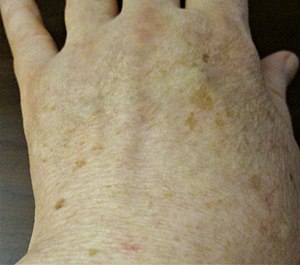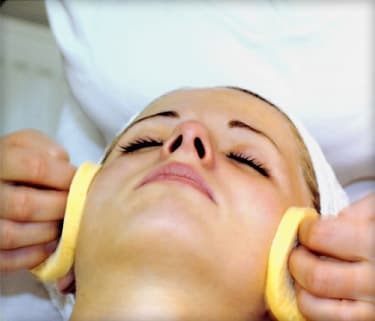As you get older, you may experience sun damage on your skin. These patches and small growths appear because of unprotected sun exposure over the course of your life.
While not always painful or dangerous to you, these spots from sun damage are widely considered a sign of aging. Sun spots will be likely be part of your life if you’re middle-aged, but that doesn’t mean you have to live with the appearance.
By predicting, identifying and considering the effect of sun damage, and of available medical options, you can treat sun damaged skin and restore the younger look you expect.
Identifying Sun Damage
By middle age, you should be checking your skin for sun spots on a daily basis. Sun damage and skin cancer are very closely related, and may look and feel the same in early stages. Sun damage takes many forms, and the skin may have different a texture and look depending on the intensity of the damage.
To identify sun damage, look for rough and dry skin lesions. You should be able to see or feel localized growths on the skin. Sun damage most often appears on the most sun-exposed areas, namely the face, scalp, back of the hands and chest.
You may be more likely to develop sun damage due to a range of genetic factors. People with fair skin are at higher risk, including those with blond and red hair. Having blue or green eyes is also considered a genetic risk factor. Behavior can also make you more or less likely to develop sun damage. If you have had long amounts of daily sun exposure in your life, you’re more likely to develop sun damage in older age.
Will Sun-damaged Skin Heal On Its Own?

Sun damaged skin can develop over a period as long as 30 years. While it’s important to change your habits to avoid unnecessary sun exposure, that’s not going to have an effect on sun damage that’s already present.
Once the skin damage is there, it may even continue to develop in different patches around the same area, even if you no longer expose it to the sun without protection. Larger spots and groups of spots can develop over a period of weeks or years based on damage that happened decades in the past.
Some sun spots are painful to the touch even if they aren’t malignant. Some are harmless but merely unsightly. If you want to remove any of them, you’ll need to consider the treatments that are available.
What Skin Treatments Target Sun Damage?
There is an impressive range of skin care treatments available that target sun damage, and they can stop the growth or erase the visibility of current spots depending on the stage.
Chemical Peels
A chemical peel is a skin treatment that can be safely repeated every few months, and will clearly reduce wrinkling and coloring that comes with sun damage.
This procedure uses a safe chemical mixture to lift off the topmost layer of skin so that the younger, collagen-rich skin from below is revealed.
These sun damage treatments aren’t a permanent solution, but they are effective for treating the appearance of sun-damaged skin.
Laser Treatments
There are several laser treatments that can be used to treat sun damage. Both the Erbium laser and the Fractional CO2 laser are likely to be available at a skin clinic near you.
Both devices work by creating precise burns in the skin that drive the development of fresh skin. As the procedure heals, the sun-damaged spots are no longer visible.
Photodynamic Therapy
Photodynamic therapy is skin healing that’s promoted by exposure to rapid bursts of blue light on a topical solution rubbed on the skin. Like the laser treatments, this one also promotes the skin to heal itself. Sun damaged skin cells fade and are replaced with fresh skin over the course of several treatments.
The Most Important Part: Prevention
Any one of these treatments may work for your existing sun spots. However, there is no treatment better than prevention when it comes to any kind of sun damage on the skin. Even if your sun damage isn’t dangerous, any bad habits related to the sun are increasingly dangerous in middle age. Change your habits not just so that you can avoid unsightly sun damage, but so that you can avoid the risk factors for skin cancer.
Make sure you always wear sunscreen when you are out of doors. Apply it to any area that will be exposed to the sun, including your face and neck. Even if you are wearing sunscreen, make sure that you always wear a hat to protect the especially sensitive skin near the eyes and cheeks.
Do your best to limit your exposure to no more than 20 minutes per day in the open sunlight. When you are out at events, try to stay close to the shade so that you don’t risk any future sun damage.
About the Author:
Born and raised in Ottawa Ontario, Dr. Craig Crippen has attended three Canadian Universities and obtained four educational titles including his Doctor of Medicine (M.D.). After receiving his M.D. from the University of Western Ontario in 2001, Dr. Crippen then completed his specialty training at the University of Manitoba over the next two years.
He has worked extensively in public and private medicine since 2003, but in response to rising demand, Dr Crippen has devoted his practice exclusively to both medical & cosmetic skin care procedures/treatments at his clinic.
A Fellow of the American Society of Laser Medicine and Surgery, and a diplomate of the American Board of Laser Surgery in Cosmetic Procedures, Dr. Crippen has trained with physicians who are at the forefront of laser & aesthetic medicine. He has made many educational visits to medical laser clinics throughout North America and Europe.
Ken Weiss is a health blogger who is passionate about natural and holistic cures for men’s health issues. He is the founder of menshealthcures.com
Thanks for sharing it…